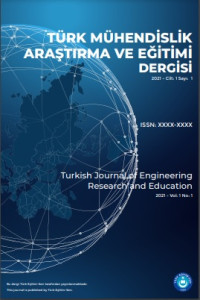Kirchhoff Yaklaşımı İntegralinin Radon Dönüşümü Yorumu ile Zaman Uzayında Belirlenmesi Üzerine
Akustik saçılma, Kirchhoff yaklaşımı, zaman uzayı analizi
On the Evaluation of the Kirchhoff Approximation Integral using Radon Transform Interpretation in Time Domain
___
- [1] J. J. Bowman, T. B. A. Senior, and P. L. E. Uslenghi, Electromagnetic and Acoustic Scattering by Simple Shapes, John Wiley and Sons, 1969.
- [2] T. B. Hansen and A. D. Yaghjian, Plane-Wave Theory of Time-Domain Fields: Near-Field Scanning Applications, Wiley-IEEE Press, 1999.
- [3] D. S. Jones, Acoustic and Electromagnetic Waves, Oxford: Clarendon Press, 1986.
- [4] W. B. Gordon, “Far-field approximations to the Kirchoff-Helmholtz representations of scattered fields,” IEEE T Antenn Propag, vol. 23, no. 4, pp. 590-592, July 1975.
- [5] W. B. Gordon, “High frequency approximations to the physical optics scattering integral,” IEEE T Antenn Propag, vol. 42, no. 3, pp. 427-432, Mar. 1994.
- [6] D. Bölükbaş and A. A. Ergin, “A Radon transform interpretation of the physical optics integral,” Microw Opt Technol Lett, vol. 44, no. 3, pp. 284–288, 2005.
- [7] H. A. Serim and A. A. Ergin, “Computation of the physical optics integral on NURBS surfaces using a Radon transform interpretation,” IEEE Antenn Wirel Propag Lett, vol. 7, pp. 70-73, 2008.
- [8] S. Karaca and A. A. Ergin, “Closed-form time domain PO expressions of the electric field scattered from PEC objects illuminated by an electric dipole,” IEEE T Antenn Propag, vol. 63, no. 10, pp. 4477-4485, Oct. 2015.
- [9] A. Aktepe and H. A. Ülkü, “On the closed-form evaluation of the PO integral using the Radon transform interpretation for linear triangles,” Turk J Electr Eng Comput Sci, vol. 29, no. 5, Article 17, 2021.
- [10]A. Aktepe and H. A. Ülkü, “Exact evaluation of time-domain physical optics integral on quadratic triangular surfaces,” IEEE T Antenn Propag, vol. 68, no. 11, pp. 7447-7456, Nov. 2020.
- [11]A. Aktepe and H. A. Ülkü, “Exact evaluation of time domain physical optics integral for high order triangles,” IEEE T Antenn Propag, vol. 71 (Early Access).
- [12]F. Vico-Bondia, M. Ferrando-Bataller, and A. Valero-Nogueira, “A new fast physical optics for smooth surfaces by means of a numerical theory of diffraction,” IEEE T Antenn Propag, 58 (3), 773–789, 2010.
- [13]Y. M. Wu, L. J. Jiang, W. E. I. Sha, and W. C. Chew, “The numerical steepest descent path method for calculating physical optics integrals on smooth conducting quadratic surfaces,” IEEE T Antenn Propag, vol. 61, no. 8, pp. 4183- 4193, Aug. 2013.
- [14]H. Kobayashi, K. Hongo, and I. Tanaka, “Expressions of physical optics integral for smooth conducting scatterers approximated by quadratic surfaces,” Electron and Commun in Japan (Part I: Commun), vol. 83, no. 7, pp. 61– 70, 2000.
- [15]M. Domingo, F. Rivas, J. Perez, R. P. Torres, and M. F. Catedra, “Computation of the RCS of complex bodies modeled using NURBS surfaces,” IEEE Antenn Propag M, vol. 37, no. 6, pp. 36-47, Dec. 1995.
- [16]A. C. Yucel and A. A. Ergin, “Exact evaluation of retarded-time potential integrals for the RWG bases,” in IEEE T Antenn Propag, vol. 54, no. 5, pp. 1496-1502, May 2006.
- [17]H. A. Ülkü and A. A. Ergin, “Analytical evaluation of transient magnetic fields due to RWG current bases,” IEEE T Antenn Propag, vol. 55, no. 12, pp. 3565-3575, Dec. 2007.
- [18]H. A. Ülkü and A. A. Ergin, “Application of analytical retarded-time potential expressions to the solution of time domain integral equations,” IEEE T Antenn Propag, vol. 59, no. 11, pp. 4123-4131, Nov. 2011.
- [19]H. A. Ülkü, A. A. Ergin, and F. Dikmen, “On the evaluation of retarded-time potentials for SWG bases,” IEEE Antenn Wirel Propag Lett, vol. 10, pp. 187-190, 2011.
- [20]F. Dikmen, “On analytical evaluation of retarded-time potentials for SWG bases,” IEEE T Antenn Propag, vol. 62, no. 9, pp. 4860-4863, Sept. 2014.
- ISSN: 2822-3454
- Başlangıç: 2022
- Yayıncı: Türk Eğitim-Sen
Çilek Tohumundan Soğuk Sıkımla Elde Edilen Yağların Biyoaktif Bileşenleri ve Yağ Asidi Kompozisyonu
Osman KOLA, Erva PARILDI, Neslihan KEÇELİ, Murat Reis AKKAYA
LiFePO4 Bataryalarda Güncel Çalışmalar
Yan Kanal Saldırılarında Güç Analizi için Deneysel bir Altyapı
Halil Said CANKURTARAN, Ali BOYACI, Serhan YARKAN
Rawan RAMADAN, Hassan GHANEM, Jamal KHATİB, Adel ELKORDİ
Kirchhoff Yaklaşımı İntegralinin Radon Dönüşümü Yorumu ile Zaman Uzayında Belirlenmesi Üzerine
Aslıhan AKTEPE, Ahmet Arif ERGİN, Hüseyin Arda ÜLKÜ
Akıllı Şehirler için Nesnelerin İnterneti ve Bulut Tabanlı bir Uygulama
H. Sercan ÇUBUK, Gökhan KURT, Uğur ÇAVDAR
Aşırı Akım Röle Koordinasyonu için Bozkurt Algoritmasının Kapsamlı Performans Analizi
